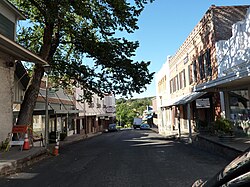2020 census
San Andreas CDP, California – Racial and ethnic composition
Note: the US Census treats Hispanic/Latino as an ethnic category. This table excludes Latinos from the racial categories and assigns them to a separate category. Hispanics/Latinos may be of any race.| Race / Ethnicity (NH = Non-Hispanic) | Pop 2000 [26] | Pop 2010 [27] | Pop 2020 [28] | % 2000 | % 2010 | % 2020 |
|---|
| White alone (NH) | 2,310 | 2,330 | 2,270 | 88.34% | 83.72% | 75.82% |
| Black or African American alone (NH) | 2 | 17 | 26 | 0.08% | 0.61% | 0.87% |
| Native American or Alaska Native alone (NH) | 35 | 36 | 39 | 1.34% | 1.29% | 1.30% |
| Asian alone (NH) | 19 | 27 | 53 | 0.73% | 0.97% | 1.77% |
| Native Hawaiian or Pacific Islander alone (NH) | 0 | 1 | 6 | 0.00% | 0.04% | 0.20% |
| Other race alone (NH) | 7 | 0 | 26 | 0.27% | 0.00% | 0.87% |
| Mixed race or Multiracial (NH) | 76 | 117 | 210 | 2.91% | 4.20% | 7.01% |
| Hispanic or Latino (any race) | 166 | 255 | 364 | 6.35% | 9.16% | 12.16% |
| Total | 2,615 | 2,783 | 2,994 | 100.00% | 100.00% | 100.00% |
The 2020 United States census reported that San Andreas had a population of 2,994. The population density was 356.9 inhabitants per square mile (137.8/km2). The racial makeup of San Andreas was 80.1% White, 1.2% African American, 1.8% Native American, 1.8% Asian, 0.3% Pacific Islander, 4.4% from other races, and 10.5% from two or more races. Hispanic or Latino of any race were 12.2% of the population. [29]
The census reported that 92.4% of the population lived in households, 1.0% lived in non-institutionalized group quarters, and 6.6% were institutionalized. [29]
There were 1,172 households, out of which 24.7% included children under the age of 18, 37.3% were married-couple households, 8.6% were cohabiting couple households, 34.9% had a female householder with no partner present, and 19.2% had a male householder with no partner present. 33.7% of households were one person, and 20.0% were one person aged 65 or older. The average household size was 2.36. [29] There were 671 families (57.3% of all households). [30]
The age distribution was 20.2% under the age of 18, 5.9% aged 18 to 24, 22.6% aged 25 to 44, 25.6% aged 45 to 64, and 25.7% who were 65 years of age or older. The median age was 46.2 years. For every 100 females, there were 97.5 males. [29]
There were 1,296 housing units at an average density of 154.5 units per square mile (59.7 units/km2), of which 1,172 (90.4%) were occupied. Of these, 59.0% were owner-occupied, and 41.0% were occupied by renters. [29]





